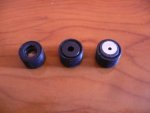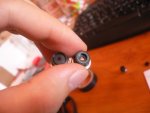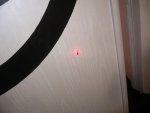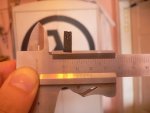Krutz
0
- Joined
- Nov 21, 2007
- Messages
- 1,733
- Points
- 48
so, after some sidenotes about this idea in other threads, i now tried to remove the red LOC diodes wings with apertures.
i compared these apertures, all with the exact same aixiz acrylic lens:
(virtualvillage, back open) (for comparison)
5 mm, back opened
2 mm, stock
1.5mm
"stock aperture flipped" (more later)
1 mm
to tighten the aperture, i glued aluminum foil (from a "tea-candle") over the back, painted it black, punched a needle through it, and then widened it to 1 mm and then 1.5 mm with a tiny drillbit.
output-power, all with the same laser and battery:
(virtualvillage, back open) 360mw
5 mm, back opened 330mw
2 mm, stock 325mw
1.5mm 244mw
"stock aperture flipped" 242mw
1 mm 160mw
by flipping the aperture"cap", the pinhole is closer to the lens, which reduces the NA just the same as having a smaller aperture.
so, what did it look like? i only used one laser, so i couldnt compare it side-by-side. while testing, it all looked promising, i made a lot of measurements and pics and different apertures. then, loading the pics on my computer and comparing, wth? i couldnt even distinguish the wings! even the 1mm aperture produced wings which looked just like the non-aperture wings, at least on the pics! i dont bother uploading dozens of identical pics, one with the wings will do.. damn, bummer!
so, since it makes almost no difference, i may as well open up the back of the lenses to gain 1% more power.. *sigh*
manuel
i compared these apertures, all with the exact same aixiz acrylic lens:
(virtualvillage, back open) (for comparison)
5 mm, back opened
2 mm, stock
1.5mm
"stock aperture flipped" (more later)
1 mm
to tighten the aperture, i glued aluminum foil (from a "tea-candle") over the back, painted it black, punched a needle through it, and then widened it to 1 mm and then 1.5 mm with a tiny drillbit.
output-power, all with the same laser and battery:
(virtualvillage, back open) 360mw
5 mm, back opened 330mw
2 mm, stock 325mw
1.5mm 244mw
"stock aperture flipped" 242mw
1 mm 160mw
by flipping the aperture"cap", the pinhole is closer to the lens, which reduces the NA just the same as having a smaller aperture.
so, what did it look like? i only used one laser, so i couldnt compare it side-by-side. while testing, it all looked promising, i made a lot of measurements and pics and different apertures. then, loading the pics on my computer and comparing, wth? i couldnt even distinguish the wings! even the 1mm aperture produced wings which looked just like the non-aperture wings, at least on the pics! i dont bother uploading dozens of identical pics, one with the wings will do.. damn, bummer!
so, since it makes almost no difference, i may as well open up the back of the lenses to gain 1% more power.. *sigh*
manuel







